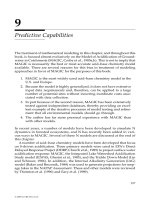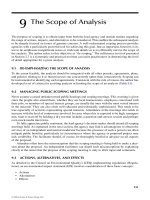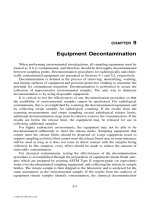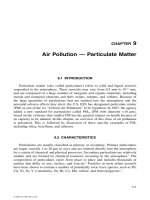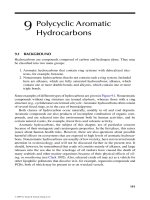Chapter 9 pot
Bạn đang xem bản rút gọn của tài liệu. Xem và tải ngay bản đầy đủ của tài liệu tại đây (412.37 KB, 53 trang )
© 2008 Pearson Prentice Hall, Electronic Commerce 2008, Efraim Turban, et al.
Chapter 9
Mobile Computing and Commerce
and Pervasive Computing
9-2
Learning Objectives
1. Describe the mobile computing environment that
supports m-commerce (devices, software, services).
2. Describe the four major types of wireless
telecommunications networks.
3. Define mobile commerce and understand its
relationship to e-commerce.
4. Discuss the value-added attributes, benefits, and
fundamental drivers of m-commerce.
5. Discuss m-commerce applications in finance,
shopping, advertising, and provision of content.
6. Describe the application of m-commerce within
organizations.
9-3
Learning Objectives
7. Understand B2B and supply chain
management applications of m-commerce.
8. Describe consumer and personal applications
of m-commerce.
9. Understand the technologies and potential
application of location-based m-commerce.
10.Describe the major inhibitors and barriers of
m-commerce.
11.Discuss the key characteristics and current
uses of pervasive computing.
9-4
Mobile Computing:
Content, Infrastructure, and Services
New Computing Environment: Mobile
Computing
Mobile devices
personal digital assistant (PDA)
A handheld computer principally used for personal
information management
smartphone
Internet-enabled cell phone that can support mobile
applications
Blackberry
A handheld device principally used for e-mail
9-5
Mobile Computing:
Content, Infrastructure, and Services
9-6
Mobile Computing:
Content, Infrastructure, and Services
Conversion of devices
These handheld devices blend blogging, Instant
Messages, SMS, and other forms of social
networking in which Web browsing is easy,
especially with a full keyboard
wireless mobile computing (mobile
computing)
Computing that connects a mobile device to
a network or another computing device,
anytime, anywhere
9-7
Mobile Computing:
Content, Infrastructure, and Services
Enabling Technologies for Mobile
Computing
Hardware and software infrastructures that
support the wireless connection include
Network access points
Mobile communications server switches
Cellular transmitters and receivers
9-8
Mobile Computing:
Content, Infrastructure, and Services
Mobile Computing Software
Mobile operating system
Mobile application user interface
microbrowser
Wireless Web browser designed to operate with
small screens and limited bandwidth and memory
requirements
Wireless Application Protocol (WAP)
A suite of network protocols designed to enable
different kinds of wireless devices to access WAP
readable files on an Internet-connected Web server
9-9
Mobile Computing:
Content, Infrastructure, and Services
9-10
Mobile Computing:
Content, Infrastructure, and Services
Markup languages
Wireless Markup Language (WML)
A scripting language used to create content in the
WAP environment; based on XML, minus
unnecessary content to increase speed
Compact Hypertext Markup Language (cHTML)
A scripting language used to create content in
i-mode
9-11
Mobile Computing:
Content, Infrastructure, and Services
Extensible Hypertext Markup Language
(xHTML)
A general scripting language; compatible
with HTML; a standard set by W3
Consortium
voice XML (VXML)
An extension of XML designed to
accommodate voice
9-12
Mobile Computing:
Content, Infrastructure, and Services
Supporting devices
synchronization
The exchange of updated information with other
computing devices
Docking stations
Attachable keyboards
Batteries
Media players
9-13
Mobile Computing:
Content, Infrastructure, and Services
Mobile Computing Services
Short Message Service (SMS)
A service that supports the sending and
receiving of short text messages on mobile
phones
Enhanced Messaging Service (EMS)
An extension of SMS that can send simple
animation, tiny pictures, sounds, and
formatted text
9-14
Mobile Computing:
Content, Infrastructure, and Services
Multimedia Messaging Service (MMS)
The emerging generation of wireless
messaging; MMS is able to deliver rich
media
micropayments
Electronic payments for small-purchase
amounts (generally less than $10)
9-15
Mobile Computing:
Content, Infrastructure, and Services
Location-based services
global positioning system (GPS)
A worldwide satellite-based tracking system that enables
users to determine their position anywhere on the earth
Voice-support services
interactive voice response (IVR)
A voice system that enables users to request and receive
information and to enter and change data through a
telephone to a computerized system
voice portal
A Web site with an audio interface that can be accessed
through a telephone call
9-16
Wireless Telecommunications Networks
personal area network (PAN)
A wireless telecommunications network
for device-to-device connections within a
very short range
Bluetooth
A set of telecommunications standards
that enables wireless devices to
communicate with each other over short
distances
9-17
Wireless Telecommunications Networks
Wireless Local Area Networks and Wi-
fi
wireless local area network (WLAN)
A telecommunications network that enables
users to make short-range wireless
connections to the Internet or another
network
Wi-Fi (wireless fidelity)
The common name used to describe the
IEEE 802.11 standard used on most WLANs
9-18
Wireless Telecommunications Networks
802.11b
The most popular Wi-Fi standard; it is inexpensive
and offers sufficient speed for most devices;
however, interference can be a problem
802.11a
This Wi-Fi standard is faster than 802.11b but has
a smaller range
802.11g
This fast but expensive Wi-Fi standard is mostly
used in businesses
9-19
Wireless Telecommunications Networks
wireless access point
An antenna that connects a mobile device to
a wired LAN
hotspot
An area or point where a wireless device
can make a connection to a wireless local
area network (using Wi-Fi)
9-20
Wireless Telecommunications Networks
9-21
Wireless Telecommunications Networks
Municipal Wi-fi Networks
WiMax
A wireless standard (IEEE 802.16) for making
broadband network connections over a medium
size area such as a city
wireless metropolitan area network (WMAN)
A telecommunications network that enables users
to make medium-range wireless connections to the
Internet or another network
9-22
Wireless Telecommunications Networks
9-23
Wireless Telecommunications Networks
WIRELESS WIDE AREA NETWORKS
wireless wide area network (WWAN)
A telecommunications network that offers wireless
coverage over a large geographical area, typically
over a cellular phone network
Physical topology of a WWAN
subscriber identification module (SIM) card
An extractable storage card used for identification,
customer location information, transaction processing,
secure communications, etc.
9-24
Wireless Telecommunications Networks
WWAN communication bandwidths
1G
The first generation of wireless technology,
which was analog based
2G
The second generation of digital wireless
technology; accommodates voice and text
2.5G
An interim wireless technology that can
accommodate voice, text, and limited graphics
9-25
Wireless Telecommunications Networks
3G
The third generation of digital wireless technology;
supports rich media such as video
3.5G
This generation was inserted into the ranks of cell
phone generations; it refers to the packet-switched
technologies used to achieve higher transmission
speeds
4G
The expected next generation of wireless
technology that will provide faster display of
multimedia

